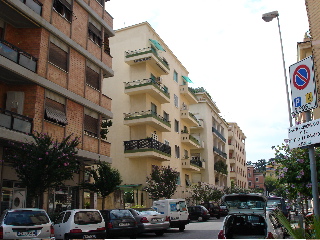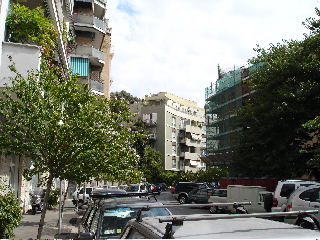|
|
 |
|
Northern Rome |
|
written
by odis / 09.18.2004 |
|
|
|
|
|
| <click to type page headline> <use TAB to move to next textbox> |
1 of 1 |
|
| |
The social characteristics of the residents |
| |
| |

|
|
| Residential Apartments |
|
| |
|
| |

|
|
| Apartments and Foliage |
|
| |
|
In determining some of the predominant social characteristics of the residents of the area we visited, we frequently had to rely on the attributes of the environment- its residential buildings, the types of shops, the aesthetic appearance of its streets, etc.- because, other than a piazza we walked through during the lunch hour, there was no great concentration of people on the streets or in the stores. One of the more interesting characteristics of the area had to do with its apartments and houses. Just off of one of the main roads, Via Nomentana, there was a high concentration of apartment buildings, many of them with gated entrances and a number of apartment decks. The area exudes a feeling of having once supported a class of the newly rich, which at first spent more extravagantly, but has now settled into the more stable spending of the middle class. This is seen from the fact that they allowed the bright colors of their buildings to fade to a more muted color. The more modern buildings all seem to have been built around the same time in the same style. Since then, it looks as though few improvements have been made, signaling the new inhabitants have stopped spending money on exterior building and renovation.
Not far from this particular area is a smaller sector that consists of a few blocks which contain other gated apartment buildings and houses. The structures themselves are far more aesthetically impressive and, presumably, expensive. They often had gardens along the side, and driveways from which well-kempt cars would emerge. The residences of most of this area are walled. All the apartment buildings, as well as the giant houses, had walls higher than a person surrounding them. Only those with permission could enter.
Another distinct characteristic of the area was the amount of foliage present. Not only did trees frequently line the streets, but, as previously mentioned, people had private gardens as well. Branches from large tree often spilled over onto the side walk, providing shade to those who walked by. There was a small park in the middle of one square, filled with trees, grass and flowers. Many of the trees around the area also bloomed with flowers. All of the foliage was green and looked healthy despite the heat of summer. Assuming that residential buildings and their environs are a strong indicator of an area’s general social class, we have drawn the conclusion that Northern Rome is predominantly middle class, with hints of upper middle class and even upper class.
Although the residential set-up gave the area a more privatized and exclusive feeling, there was still an atmosphere of neighborhood unity. As we were walking, we saw two old women stop in the street and greet each other. Their gestures and tone made the encounter seem like a daily occurrence. This same scene played out more than once with different people. In the park, there were quite a few people sitting on the benches, chatting. In one corner, a small group of old men were gathered, deep in conversation. Although their homes are walled, they seemed to be very social and in touch with their neighbors.
The homogeneity of this park scene was strong; there were very few people younger than thirty-five, and a great number of those socializing would be of senior citizens’ status in the United States. This high concentration of older persons might be attributed to the hour in which we were observing- around noon and the early hours of the afternoon- but their numbers were too great not to be considered a significant chunk of the area’s population.
In regards to sexual preferences, beyond the common male and female couple walking down the street, there was no particular evidence that the area was anything but overtly heterosexual. Concerning ethnicity, the greatest variety included a small number of the street vendors. We found one Chinese restaurant. Along the main routes (such as Via Nomentana and Via Regina Elena), a greater concentration of ethnic diversity existed (again, primarily street vendors), but those people that made up the sidewalk’s foot traffic appeared to be predominantly Italian or tourists. Tourists- or non-Italians (based on the language spoken)- seemed obviously present only on these main routes. The residential areas, which make up a significant chunk of the larger Northern district , and the shopping areas both had limited numbers of tourists.
|
| |
|
| |
|
| |
The distinctive economic and consumption activity in the neighborhood |
| |
This area does not seem to have much of economic activity. It appears to be more of a residential area. We saw many modern apartment buildings that are five to six stories tall, all in the same area, more than a few with mini cars parked outside on the street. Most of the stores and shops are on the main streets.
Based on the streets we visited, there seem to be many boutiques catering toward the middle class. Many of them didn’t seem like local businesses, however, because we have seen their names in other parts of Rome or Italy. There were lots of clothing shops for middle age women, restaurants, pastry shops and ice cream shops. Interestingly, we saw a couple of street vendors selling clothes, shoes and accessories that were similar to those being sold by the stores that they were on the street in front of. Not surprisingly, those street vendors were selling them at a much cheaper price. Since this street doesn’t seem to cater to tourists (and because we saw very few persons who looked to be tourists), their primary customers are likely the neighborhood residents.
The shoe stand had a number of used shoes, and a number of stands were selling mostly makeup and cleaning products. Furthermore, we saw a huge toy store on the main street that had a good supply of beautiful dolls and nursery items. These items were definitely catering toward young couples who were newly wed or who have recently had babies. The fact that the store is large indicates a significant demand for these items; one might therefore expect that a larger proportion of nearby residents are young and/or recently married relative to the larger Rome area.
While walking down one residential street we did see a girl who appeared to be in her 20s delivering a stack of Ikea magazines to various apartment buildings. Since Ikea is a well known store typically associated with a middle class budget and a younger (or hipper) crowd, we considered it to be an important indication of the type of economic activity the members of this neighborhood engage in.
|
| |
|
| |
|
| |
Generalizations about the character/culture of the area |
| |
The character of our area looked as though at some point, maybe the late 80’s or early 90’s, it was more hip and stylish. The paint on the buildings look as though they were once bright, but now have faded to a more muted color. The different colors of paint that can be seen are off-white, yellow, orange, red, light blue, and mint green. These colors seem to have been coordinated; no buildings of the same color are directly next to each other. Also, it is interesting to note that this décor of colors seems to be similar to the Art Deco style. Additionally, this type of decoration seems to imply that the area supported a new bourgeois at the time, as the buildings painted are predominantly more modern compared to the others in the area.
Although we did walk past a nun feeding pigeons, there was no other clear sign of a religious presence. If there were any churches in the area, they either blended in with surrounding buildings or existed further outside the area. The only church buildings we encountered in the area were the Church of Santa Costanza and the Church of St. Agnes. There were no worshippers in Santa Costanza, and only nuns in the Church of St. Agnes. Unlike other areas that we have toured in the past, we saw no religious imagery in what might otherwise be considered secular spaces, and we never encountered religious items being sold either on the street or in the stores.
In this area there is also a military base. Although its architecture blends somewhat into the rest of the surrounding structures, it still stands out, clearly marked with military signs. The painting is done in the same type of color as the surrounding buildings, but instead of being faded, it is much brighter. The theme of foliage is also kept up, with bushes and small trees lining the façade. It too requires permission for entry. Several times the gates opened for cars, but it is interesting to note that the cars were all of the more expensive variety with tinted windows. This gives a feeling of secrecy, providing an interesting contrast to the neighborhood unity described above.
|
| |
|
| |
|
|
 |
|


